Have you ever wondered what the difference is between a Marching French horn and a Mellophone? Which one is in Marching Band?
A regular French Horn can be played on the field but is hard to hear due to its back-facing bell. Instead, you will play a Marching French Horn or Mellophone during marching season. Both horns have forward-facing bells and are held in a playing position just like a Trumpet. Marching French Horns can be used; however, most marching bands use Mellophones.
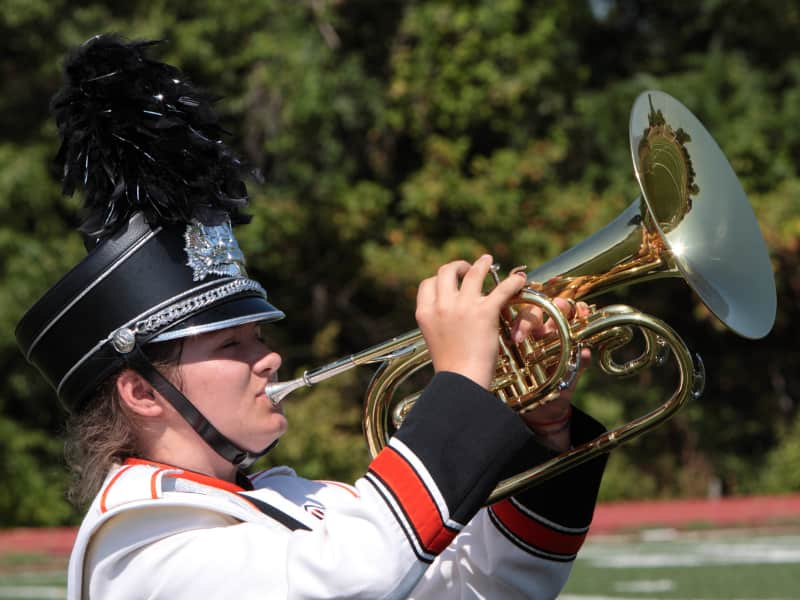
Keep reading to learn more about the Marching French Horn and Mellophone!
Are there French Horns in Marching Band?
Yes! There are French Horns in a Marching Band, they are members of the brass section of the band. A Marching French Horn is in the middle range of brass instruments.
While you can march with a concert French Horn, it is difficult to hold while marching. That is why during marching season, players will switch to a Marching French Horn or a Mellophone. Both horns sound like a French Horn and play French Horn parts in music.
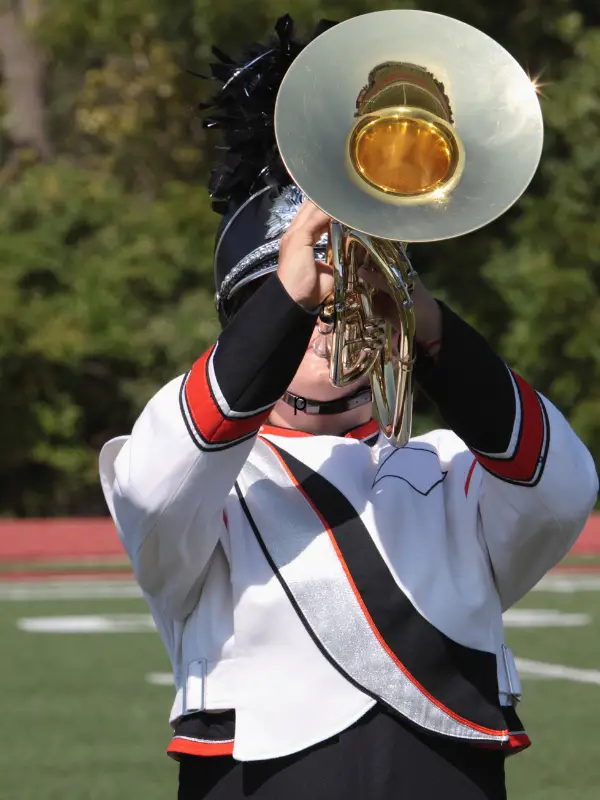
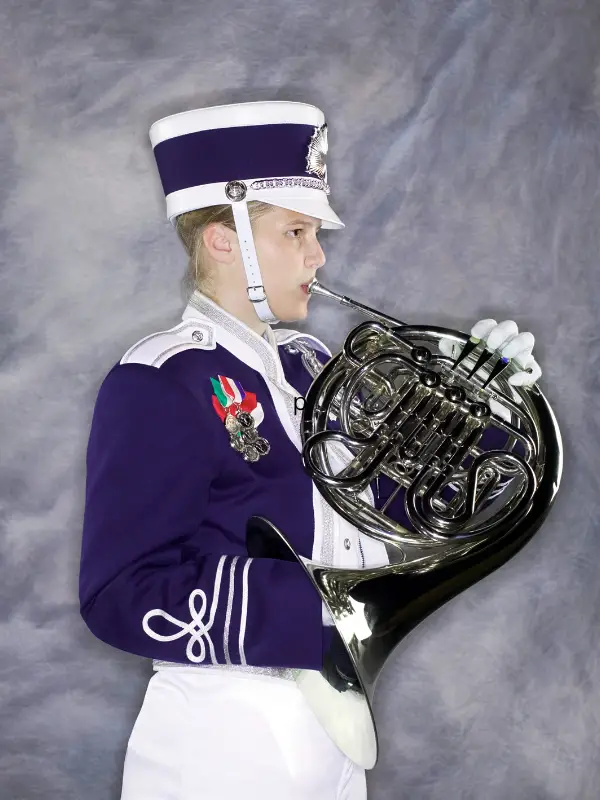
What is a Marching French Horn
There are two instruments that are very similar to each other and both qualify as a “Marching French Horn” in the Marching band. They are called, the Marching Horn, and the Mellophone. Both horns have forward-facing bells and can play French Horn music.
A Marching French Horn is in the key of Bb and is sometimes called the Bb Marching Horn. This horn is the same as the Bb side of a double horn. A Marching French Horn has longer valve slides and a wider wrap of the tubing. It uses a French Horn mouthpiece.
Note: The Marching French Horn is easier to play for French Horn players. The two instruments have the same fingerings for upper and lower register notes.
A Mellophone is best described as a re-wrapped French Horn with a forward-facing bell. A Mellophone has a tighter wrap than the Marching French Horn. Mellophones have three valves on top of the instrument, unlike keys on the side like a French Horn.
The fingering used to play the Mellophone is the same as the fingering used by trumpet players.
If you want to march French Horn in a band, it helps to learn the trumpet first, but if you can’t, that is okay as well.
A Mellophone has a tuning slide that controls the pitch and uses trumpet mouthpieces. Mellophones can be pitched to the key of either Bb or F, but F Mellophones are more commonly used.
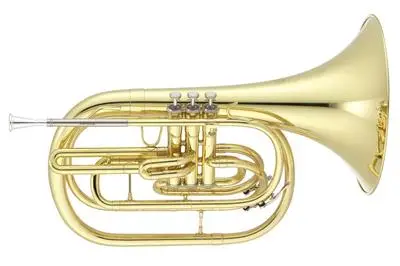
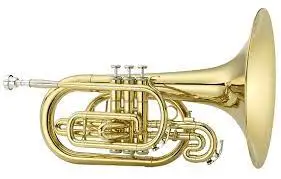
How and Where to Buy a French Horn for Marching Band?
Horns, like all instruments, are expensive and should be thought of as an investment. There are three options for purchasing a French Horn or Mellophone for Marching Band.
Option one is going to a music instrument store near you. Call the store first to see if they have any Mellophones in stock. Not all instrument stores carry marching instruments.
Option two is to buy the horn you want online. You can go to the website for the brand of horn you want. You also can order online from a music company. Some reliable music companies that sell Mellophones and Bb Marching Horns online are
- Woodwind & Brasswind
- Musician’s Friend
- Music & Arts
- Pro Winds
Option three is to buy one from an online auction site like eBay or Reverb. Do some research and make sure the instrument you get is the correct one. Knowing some brands and model numbers/names will help you find what you are looking for.
There is no difference between a Marching French Horn or Mellophone for high school students or college students. A horn is suitable for high school use and college rehearsals/practice as long as it plays and can be tuned.
If you plan to audition for a Drum Corps International (DCI) band check the corps FAQ pages to know if you need a horn or it will be provided for you. For DCI most corps require you to bring your own mouthpiece (typically a mellophone mouthpiece only).
Any person who has been in a marching band will recommend having a different horn for practices. Having a more affordable or used horn with minor dents and scratches for rehearsals in high school and college bands will be okay.
What Brands are the Best?
There are three popular brands of Mellophones or Marching Horns. These brands are Jupiter, King, and Yamaha. Below is a comparison chart for the best horns from Jupiter, King, and Yamaha. All the horns in the chart are quality Marching French Horns and Mellophones but they are different in measurements, price, and keys.
Name | Key | Bore Size | Bell Size | Weight | Mouthpiece | Comes With Case? | Price: Lacquer (gold) | Price: Silver |
Yamaha YMP-204M Series Marching Mellophone | F | 0.462” | 10” | 3.5 lbs | 14F4 Mellophone mouthpiece with a French Horn Adapter | Yes | $1,825.99 | $2,169.99 |
| Yamaha YHR-302M Marching Horn | Bb | 0.472” | 10.8” | 3.5 lbs | French Horn | Yes | $2,403.99 | $2,633.99 |
| King 1121 Ultimate Series Mellophone | F | 0.468” | 10.7” | 3.5 lbs | Included with Horn | Yes | $2,109.00 | $2,339.00 |
| Jupiter JMP 1000M Qualifier Series F Mellophone | F | 0.462” | 10” | 3.3 lbs | Trumpet & French Horn | Yes | $1,559.00 | $2,044.00 |
| Jupiter JMP 1101 Quantum Mellophone | F | 0.460” | 10.7” | 3.5 lbs | Included with Horn | Yes | $1,944.00 | $2,334.00 |
| Jupiter JHR 1000M Qualifier Series Bb Marching Horn | Bb | 0.468” | 10” | 3.9 lbs | French Horn | Yes | $1,724.00 | $2,169.00 |
The lacquer-coated horns which will have a golden (high shine brass) color will always cost less than silver-coated horns. In high school, the color doesn’t matter as much.
In college, your band may provide all silver horns to the band for use during football games and performances. This makes sure everyone’s horns are all the same color and brand.
You are not required to buy your own Mellophone or Bb Marching Horn; you can rent one for the marching season!
How to Rent a French Horn for Marching Band
Since instruments are costly, renting is always an option and is very common. Most high school band programs will have a few horns they can loan to students. There may not be any Marching Horns at the school because Mellophones are preferred by marching bands today.
You can rent a horn from a local instrument/music store if they have a rental program. A small amount of money is paid each month for the horn. When the season ends, it is returned to the instrument store it came from. Adding instrument insurance is a good idea. If your instrument is damaged in any way, you will be responsible for paying part of the repair fee rather than all of it.
There are also rental programs known as a rent-to-buy program. A rent-to-buy program is just like a normal rental program, paying a set amount each month to use it. What is different with a rent-to-buy program is that you can purchase the horn you have been renting at the end of the season.
How to Hold a French Horn in Marching Band
Holding positions for both the Bb Marching Horn and Mellophone are the same. To properly hold your horn the pinky finger of your right hand is placed in the ring on the top of the horn near the valves.
Your right thumb should be placed between the first and second valve casings. The tips of your right hand’s first, middle, and ring fingers will rest on the valve caps. The first finger on the first valve, middle on the second, ring finger on the third valve.
The left-hand position is incredibly easy. Your thumb of the left hand will rest on the first valve casing. Some horns have a ring on this part of the body where your pinky finger goes. If you don’t have a second ring, don’t worry. Wrap the fingers around the valve casings with your left palm touching them. Your hand will look like a large C if the horn is taken out of the hands.
The wrists should not touch the horn or bend. The elbows are pointed out and away from the body at a 45-degree angle. Your section leader or members of your section will help you out if they see something wrong. Your wrists should not cramp while holding your horn, a cramp means you are not in a proper holding position.
Here is a video of a Mellophone player explaining how to correctly hold the horn.
How Much Does a Marching French Horn Cost?
The cost of a Marching French Horn or Mellophone depends on whether it is new or used and the finish of the horn. Used horns will always cost less than new horns. As long as the horn is in good playing condition, a used horn is just as good as a new one.
The average cost of a lacquer Mellophone is between $1,500 and $2,400. For silver Mellophones, the average cost is around $2,500. The average cost of a lacquer Marching Horn is around $2,000 and for the silver finish horn is about $2,500.
Not all music stores or websites charge the same price for each instrument. If you are buying a Marching French Horn or Mellophone, a budget of $3,000 is perfect for a horn and a mouthpiece if you need a different one. It is always a good idea to do some research comparing models and prices before making a purchase.
How Much Does a Marching French Horn Weigh?
Mellophones and Marching French Horns are both relatively light instruments. Both horns are around 3.5 pounds. At the end of the article is an exercise you can do if you are worried about not being strong enough to hold your horn.
Best Marching French Horn Mouthpiece
The best mouthpiece for a Bb Marching French Horn will be the exact same mouthpiece you use when playing French Horn in a concert setting.
If you are buying or know that you will be playing the Mellophone there are two options. Use a Trumpet mouthpiece or a French Horn mouthpiece with an adapter. Most college marching bands with Mellophones will want its members to use a Trumpet mouthpiece.
Some of the best Mellophone mouthpieces are listed below
- Yamaha Standard Series Mellophone Mouthpiece
- Bach Mellophone Mouthpiece in Silver 6
- Hammond Mellophone Mouthpiece either a 5MP or 6MP
- Blessing Mellophone Mouthpiece 5 or 6
Best Marching French Horn Case
All instruments bought from a store or rented from a store and a school will come with a case. If you buy a horn from an auction website like eBay, the horn might not come with a case. O ifr the case is in bad condition, bying a case is recommended. There are two different cases you can buy. There aren’t many options because instruments almost always come in a case.
The best Marching French Horn and Mellophone cases are listed below:
- Protec Pro Pac Mellophone Case
- MTS Products 1360V Marching Brass Case
Marching French Horn and Mellophone Strength Training
This strength training is not mandatory or required. If you do not want to do it, that is fine. This exercise is for musicians that are worried about being strong enough to hold their horns. Doing this regularly during the summer before marching season starts can help you feel more confident.
The weight of Marching French Horns are, on average, 3.5 pounds. That is not too heavy. What makes the horns feel heavy is due to the holding position of the horn. You aren’t only holding a horn, but both arms up as well.
The weight of human arms is 6.5% of your total body weight. The number will be around 7-20 pounds depending on your body weight. You should calculate the weight of your arms and add another 3 or 4 pounds to that number. The extra 3 or 4 pounds added at the end represents the weight of your horn and arms together.
You will need a dumbbell that weighs the same or a bit heavier than the weight of your arms and horn together. Hold one weight with both hands at mouth level (away from the body) and your arms like you are playing a trumpet. You can stand in place and hold the weight or walk around to mimic marching.
If you practice a few times a week you will build muscles and strength to be able to hold the weight. It will make holding the Marching French Horn or Mellophone a breeze. You can buy dumbbells from fitness stores, Target, Walmart, and on Amazon.
Disclaimer: This post may contain affiliate links. We only recommend high-quality products that are used and recommended by real musicians. If you use these links to buy something we earn a small commission.
